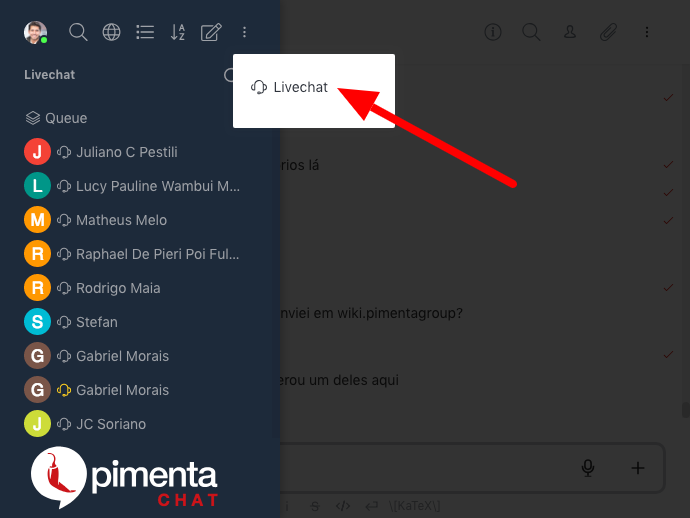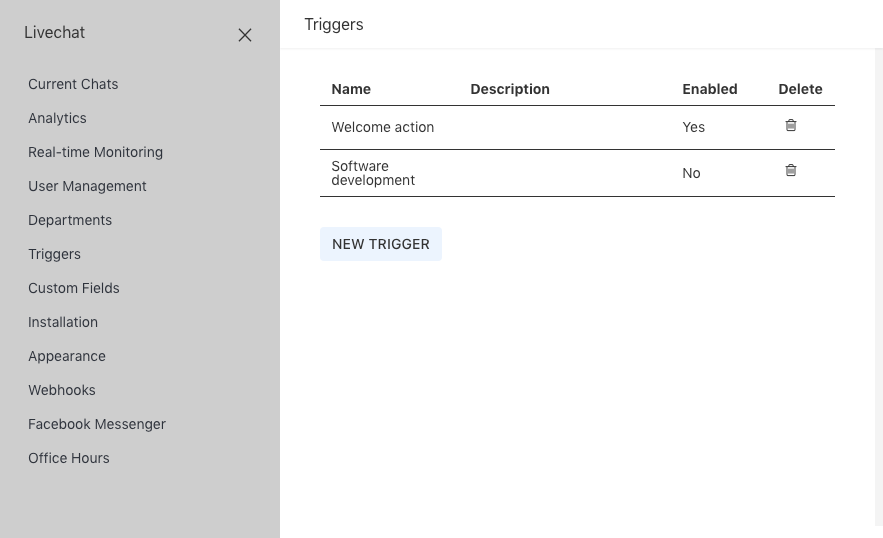Livechat in pimentaCHAT
pimentaCHAT had minimal Livechat as a feature for a long time.
Recently the demand for production-grade Livechat has increased, so we started a complete rewrite of the package.
This document contains instructions on setting up the new Livechat work-in-progress version.
You can find the perfect design guidelines here:pimentaCHAT LiveChat Support design guidelines
Introduction
Livechat package adds the ability to embed a pop-up support chat to your website.
Activation and Configuration
Enable Livechat feature
First, you have enable the Livechat feature on your pimentaCHAT instance. Go to Administration > Settings > Livechat and enable it.
Now the admin will have access to Livechat manager through a new menu called Livechat at the top left corner drop down menu.

Configure Livechat feature
At Livechat manager you’ll have the following configuration options:
User Management
You can add new Livechat manager users and agents.
In order to start receiving incoming live chats you need to add Livechat agents.
Departments
You can have the following behavior depending on how many departments you have created:
- No departments: all Livechat agents will receive incoming chats using a round robin rule;
- One department: all incoming chats will be offered to agents only on that department using a round robin rule;
- More than one department: the visitor will have to choose with what department he wants to talk to at registration.
Triggers
You can configure how your Livechat widget will be triggered and what it will do on your website.
You can set a condition (e.g. user access a url) and an action (e.g. send a message with the text “hello”).

Custom Fields
You can configure custom fields to be sent by the client. You can see an example on the Livechat API page.
Installation
Go to the Livechat Manager -> Installation
Then copy the code displayed into the source code of your website. You may modify it to meet your specific requirements.
Appearance
To customize the appearance of your Livechat widget goto Livechat -> Appearance
Integrations
You can use webhooks to easily integrate Livechat with your CRM.
The pimentaCHAT will send a POST to the WebHook URL when the Livechat ends or you receive a new offline message.
Here is an example of the JSON data sent on the end of a Livechat session:
{
"type": "LivechatSession",
"_id": "fasd6f5a4sd6f8a4sdf",
"label": "title",
"topic": "topic of the session",
"code": 123123,
"createdAt": "2016-06-01T18:41:16.856Z",
"lastMessageAt": "2016-06-01T18:41:16.856Z",
"tags": [
"tag1",
"tag2",
"tag3"
],
"customFields": {
"productId": "123456"
},
"visitor": {
"_id": "",
"name": "viistor name",
"username": "visitor-username",
"department": "department",
"email": "email@address.com",
"phone": "192873192873",
"ip": "123.456.7.89",
"browser": "Chrome",
"os": "Linux",
"customFields": {
"customerId": "123456"
}
},
"agent": {
"_id": "asdf89as6df8",
"username": "agent.username",
"name": "Agent Name",
"email": "agent@email.com"
},
"messages": [
{
"username": "visitor-username",
"msg": "message content",
"ts": "2016-06-01T18:41:16.856Z"
},
{
"username": "agent.username",
"agentId": "asdf89as6df8",
"msg": "message content from agent",
"ts": "2016-06-01T18:41:16.856Z"
}
]
}
Here is an example of the JSON data sent on a Livechat offline message:
{
"type": "LivechatOfflineMessage",
"sentAt": "2016-06-01T19:55:53.867Z",
"visitor": {
"name": "name from the form",
"email": "email@fromtheform.com"
},
"message": "message from the form"
}
The field Secret Token is sent to a header X-pimentachat-Livechat-Token so you can validate if the request became from the Livechat.
If your endpoint returns a response status other than 200, pimentaCHAT will retry 10 times waiting 10 seconds between retries.
Widget Embedding
Magento 2
Magento 2 depends on RequireJS to load JavaScript resources, so we need to change the widget code a little to look like:
<script defer="defer" async="async" type="text/javascript">
require([ 'jquery' ], function ($) {
(function(w, d, s, u) {
w.pimentachat = function(c) { w.pimentachat._.push(c) }; w.pimentachat._ = []; w.pimentachat.url = u;
var h = d.getElementsByTagName(s)[0], j = d.createElement(s);
j.async = true; j.src = 'https://rc.example.com/packages/pimentachat_livechat/assets/pimenta-livechat.js';
h.parentNode.insertBefore(j, h);
})(window, document, 'script', 'https://rc.example.com/livechat');
});
</script>
Replace the https://rc.example.com/ with your pimentaCHAT (sub-)domain, and paste the code into your theme file /app/design/frontend/Theme_provider/theme_name/Magento_Theme/templates/root.phtml right before the closing </html> tag.
Flush your PHP OpCode cache, and you are ready to go.
